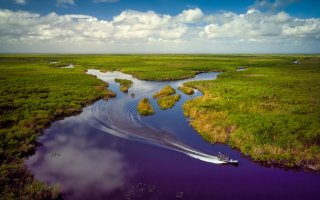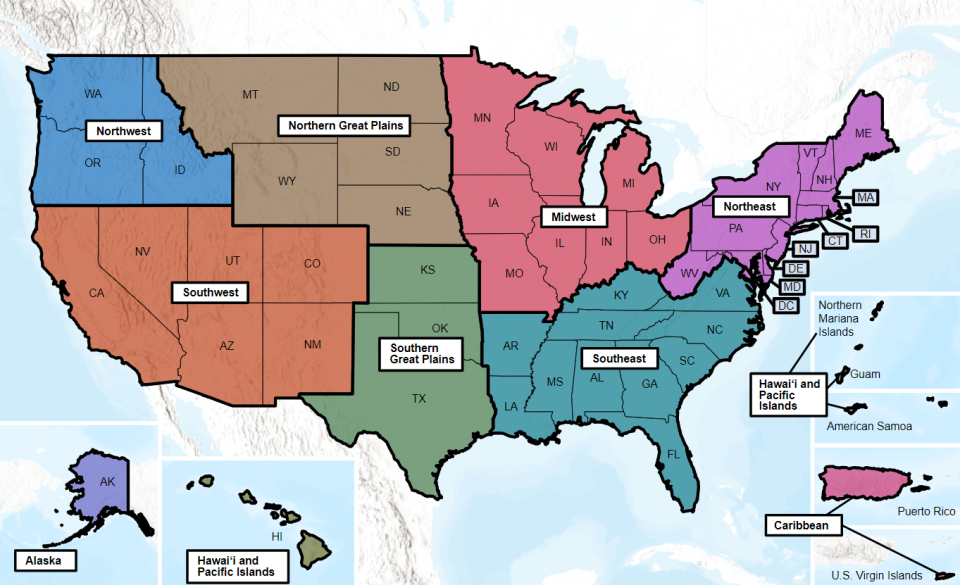Climate Change Connections: Florida (The Everglades)
Climate change is impacting all regions and sectors of the United States. The State and Regional Climate Change Connections resource highlights climate change connections to culturally, ecologically, or economically important features of each state and territory. The content on this page provides an illustrative example. As climate change will affect each state and territory in diverse ways, this resource only describes a small portion of these risks. For more comprehensive information about regional climate impacts, please visit the Fifth National Climate Assessment and Climate Change Impacts by Sector.
On this page:
Introduction: The Everglades—A Unique Wetland Ecosystem

Located at the southern tip of Florida, the Everglades comprise a mosaic of marshes, prairies, forests, mangroves, and estuaries that support rich biodiversity. Fresh water flows south from Lake Okeechobee and eventually mixes with fluctuating tides of salt water in the mangrove estuaries of Florida Bay. This enables saltwater-tolerant species to live side by side with freshwater species. Situated at the interface of temperate and sub-tropical climates, the Everglades host a diversity of species at the boundaries of their ranges.1 The Everglades are an important cultural resource as well, with nearly 15,000 years of human history.2 The Calusa and Tequesta Tribes lived in the area prior to colonization. The Miccosukee Tribes of Indians of Florida and the Seminole are active in the region today.

The Everglades are home to rich biodiversity, including dozens of threatened and endangered species.3 Some species in the Everglades, such as the Cape Sable seaside sparrow and the Florida leafwing butterfly, are found nowhere else.3 The Everglades are also the only place where both alligators and crocodiles can be found together in the wild.4 Development, drainage, and pollution issues in the mid-20th century threatened the unique ecosystems in southern Florida and soon motivated conservation efforts. Everglades National Park, which encompasses approximately 20 percent of the Everglades region, was established as a National Park in 1947 and later recognized as a UNESCO World Heritage Site. The unique natural features and wildlife of the Everglades draw visitors from near and far for fishing, boating, birdwatching, and recreation. Annually, Everglades National Park sees nearly 1 million visitors.5
Climate Impacts: Sea Level Rise and Saltwater Intrusion Threaten Ecosystems, Economies, and Public Health
Warming temperatures are causing global sea level to rise. As water warms, its volume increases in a process known as thermal expansion. Melting ice from glaciers and ice sheets adds to water in the ocean. Rising sea levels can inundate low-lying wetlands, erode shorelines, contribute to coastal flooding, and increase the flow of salt water into estuaries and nearby groundwater aquifers.6 Sea levels along U.S. coastlines rose an average of 10 to 12 inches from 1920 to 2020.7 Since 1993, the average rate of sea level rise has accelerated. Scientists project that sea level along U.S. coastlines will rise another 10 to 12 inches by 2050.6 In the southeastern United States, sea level is profoundly affecting coastal marshes and the biodiversity and ecosystem services they support.8 South Florida and the Everglades are especially vulnerable to sea level rise impacts due to the low elevation of the area (at most a few feet above sea level), flat topography, and shallow water table.9
Along the Florida coast, mangroves play a foundational role in the Everglades ecosystem. They provide important ecological benefits, including serving as habitat for a wide array of plants and animals, protecting shorelines and local sediment, improving water quality, and trapping and storing carbon dioxide in their roots. In response to rising sea levels, mangrove forests in south Florida may migrate further inland, at the expense of freshwater marshes.10 Rising sea levels, mangrove migration, and wetland shifts can have unpredictable cascading impacts for Florida’s vulnerable ecosystems that lie in transition zones.

The full scope of impacts of rising seas and changing salinity on wildlife in and around the Everglades remains uncertain, but the projected loss of habitat and marsh nurseries could harm many species.11 Researchers project that the endangered Cape Sable seaside sparrow, a ground nesting bird, will significantly decline in population with increasing sea level rise.12,13 An important factor in the stability of the Everglades is how far inland brackish water or salt water will travel. The intrusion of salt water can significantly harm the human and natural systems that are not prepared to deal with it. The National Park Service (NPS) and U.S. Department of the Interior report that saltwater intrusion in nearshore nurseries and the loss of freshwater inputs in Florida Bay could affect the abundance of ecologically important fish species, such as the tarpon, red drum, snook, mullet, and pinfish.14
Saltwater intrusion also threatens South Florida’s primary source of drinking water, the Biscayne Aquifer, which provides people with an average of nearly 1 billion gallons of water per day.15 The Biscayne Aquifer is shallow and permeable, which makes it highly vulnerable to contamination.15 The aquifer faces many simultaneous threats made worse by climate change, including rising sea level, heavy rainfall with urban runoff, and storm surges during extreme weather.16–19
Warming Temperatures Affect Water Quality and Ecosystems
Water quality on the coast can also be affected by warming water temperatures. When water temperatures increase, the water can hold less dissolved oxygen, which most marine animals need to survive. In places like Florida Bay, these lower oxygen concentrations are expected to increase the occurrence of algal blooms and massive fish kills.14 One well-known type of algal bloom, colloquially called a “red tide,” can produce toxins that kill fish or make shellfish dangerous to eat.20 When the toxin produced by red tide becomes airborne, it can cause respiratory issues and eye irritation in people.21
Warming temperatures are also expected to directly harm species living in the Everglades. For example, because the sex of alligators and crocodiles is determined by the temperature of the eggs, warmer temperatures may cause imbalanced gender ratios in these species, which could negatively affect reproduction.22 Since the Everglades lie at the northern or southern range limit for many species that live there, changing temperature patterns could push certain species out.14
Taking Action: Protecting Everglades Ecosystems in the Face of a Changing Climate
Addressing climate change requires reducing greenhouse gas emissions while preparing for and protecting against current and future climate impacts. Communities, public officials, and individuals in every part of the United States can continue to explore and implement climate adaptation and mitigation measures. In Florida, land managers are taking steps to protect the unique Everglades ecosystems, including:
- Restoration planning. Existing restoration efforts include the Comprehensive Everglades Restoration Plan (CERP), first launched in 2000. This state and federal partnership focuses on restoration of the water quality functionality of the Everglades.23 The project includes constructing canal and pump station infrastructure to manage water flow and drainage in the region.24 The plan also explores potential elevation or relocation of Everglades National Park infrastructure, such as bridges and buildings.
- Outreach and education. Everglades National Park participates in the NPS Climate Friendly Parks program, which shares resources about climate-friendly practices with visitors. These practices help visitors reduce their greenhouse gas contributions and mitigate the impacts of climate change.
To learn more about climate change impacts in Florida and the Southeast region, see Chapter 22 of the Fifth National Climate Assessment.
Related Resources
- Restoration of the Florida Everglades (EPA)
- Climate Change and Freshwater Harmful Algal Blooms (EPA)
- EvergladesRestoration.gov
- Comprehensive Everglades Restoration Plan (CERP) (NPS)
- South Florida Water Management District Comprehensive Everglades Restoration Plan Project Planning
- Recent Developments in Everglades Restoration (Congressional Research Service)
- National Park Service Everglades Curriculum Materials (NPS)
- Florida State Climate Summary 2022 (NOAA)
References
1 National Park Service. (n.d.). Everglades is internationally significant. Everglades National Park. Retrieved January 18, 2024, from https://www.nps.gov/ever/learn/news/internationaldesignations.htm
2 National Park Service. (n.d.). Native Peoples. Everglades National Park. Retrieved July 25, 2024, from https://www.nps.gov/ever/learn/historyculture/nativepeoples.htm
3 National Park Service. (n.d.). Threatened and endangered species. Everglades National Park. Retrieved January 12, 2024, from https://www.nps.gov/ever/learn/nature/techecklist.htm
4 U.S. Geological Survey. (n.d.). Do alligators and crocodiles exist together anywhere in the world? Frequently Asked Questions: Biology. Retrieved January 16, 2024, from https://www.usgs.gov/faqs/do-alligators-and-crocodiles-exist-together-anywhere-world
5 National Park Service. (n.d.). Everglades Park statistics. Everglades National Park. Retrieved July 25, 2024, from https://www.nps.gov/ever/learn/news/parkstatistics.htm
6 EPA. (2023). Climate change indicators: Sea level. Retrieved January 15, 2024, from https://www.epa.gov/climate-indicators/climate-change-indicators-sea-level
7 Sweet, W. V., Hamlington, B. D., Kopp, R. E., Weaver, C. P., Barnard, P. L., Bekaert, D., Brooks, W., Craghan, M., Dusek, G., Frederikse, T., Garner, G., Genz, A. S., Krasting, J. P., Larour, E., Marcy, D., Marra, J. J., Obeysekera, J., Osler, M., Pendleton, M., … Zuzak, C. (2022). Global and regional sea level rise scenarios for the United States: Updated mean projections and extreme water level probabilities along U.S. coastlines (NOAA Technical Report NOS 01). NOAA National Ocean Service. https://cdn.oceanservice.noaa.gov/oceanserviceprod/hazards/sealevelrise/noaa-nos-techrpt01-global-regional-SLR-scenarios-US.pdf
8 Hoffman, J. S., McNulty, S. G., Brown, C., Dello, K. D., Knox, P. N., Lascurain, A., Mickalonis, C., Mitchum, G. T., Rivers III, L., Schaefer, M., Smith, G. P., Camp, J. S., & Wood, K. M. (2023). Ch. 22. Southeast. In A. R. Crimmins, C. W. Avery, D. R. Easterling, K. E. Kunkel, B. C. Stewart, & T. K. Maycock (Eds.), Fifth National Climate Assessment. U.S. Global Change Research Program. https://doi.org/10.7930/NCA5.2023.CH22
9 Florence Bascom Geoscience Center. (2018). Sea level rise and climate: Impacts on the greater Everglades ecosystem and restoration. U.S. Geological Survey. Retrieved January 15, 2024, from https://www.usgs.gov/centers/florence-bascom-geoscience-center/science/sea-level-rise-and-climate-impacts-greater
10 Osland, M. J., Chivoiu, B., Enwright, N. M., Thorne, K. M., Guntenspergen, G. R., Grace, J. B., Dale, L. L., Brooks, W., Herold, N., Day, J. W., Sklar, F. H., & Swarzenzki, C. M. (2022). Migration and transformation of coastal wetlands in response to rising seas. Science Advances, 8(26), eabo5174. https://doi.org/10.1126/sciadv.abo5174
11 National Park Service. (n.d.). Sea-level rise In Everglades National Park. Everglades National Park. Retrieved January 15, 2024, from https://www.nps.gov/ever/learn/nature/cceffectsslrinpark.htm
12 Romañach, S. S., Haider, S. M., & Benscoter, A. M. (2023). Sea level rise may pose conservation challenges for the endangered Cape Sable seaside sparrow. Frontiers in Ecology and Evolution, 10, 1085970. https://doi.org/10.3389/fevo.2022.1085970
13 U.S. Fish and Wildlife Service. (n.d.). Cape Sable seaside sparrow (Ammospiza maritima mirabilis). ECOS: Environmental Conservation Online System. https://ecos.fws.gov/ecp/species/6584
14 Pearlstine, L. G., Pearlstine, E. V., Sadle, J., & Schmidt, T. (2009). Potential ecological consequences of climate change in South Florida and the Everglades: 2008 literature synthesis (SFNRC Technical Series 2009:1, p. 35) [Resource Evaluation Report]. National Park Service. https://erec.ifas.ufl.edu/media/erecifasufledu/docs/pdf/wildlife/TRClimateChangeLoResSecure.pdf
15 U.S. Climate Resilience Toolkit. (2019). Water resources resilience in Broward County. Retrieved January 12, 2024, from https://toolkit.climate.gov/course-lessons/water-resources-resilience-broward-county
16 EPA. (2023). Climate change indicators: Coastal flooding. Retrieved June 28, 2023, from https://www.epa.gov/climate-indicators/climate-change-indicators-coastal-flooding
17 EPA. (2023). Climate change indicators: Heavy precipitation. Retrieved October 6, 2023, from https://www.epa.gov/climate-indicators/climate-change-indicators-heavy-precipitation
18 EPA. (2023). Climate change indicators: Tropical cyclone activity. Retrieved January 15, 2024, from https://www.epa.gov/climate-indicators/climate-change-indicators-tropical-cyclone-activity
19 City of Fort Lauderdale. (n.d.). Why does sea level matter? Green Your Routine. Retrieved January 15, 2024, from https://gyr.fortlauderdale.gov/greener-government/climate-resiliency/climate-and-weather-in-fort-lauderdale/the-story-of-sea-level-rise-in-fort-lauderdale/why-does-sea-level-matter
20 National Ocean Service. (2023). What is a red tide? NOAA. Retrieved February 22, 2024, from https://oceanservice.noaa.gov/facts/redtide.html
21 NOAA National Ocean Service. (2024). Gulf of Mexico/Florida: Harmful algal blooms. Hazards. Retrieved July 25, 2024, from https://oceanservice.noaa.gov/hazards/hab/gulf-mexico.html
22 Bock, S. L., Lowers, R. H., Rainwater, T. R., Stolen, E., Drake, J. M., Wilkinson, P. M., Weiss, S., Back, B., Guillette, L., & Parrott, B. B. (2020). Spatial and temporal variation in nest temperatures forecasts sex ratio skews in a crocodilian with environmental sex determination. Proceedings of the Royal Society B: Biological Sciences, 287(1926), 20200210. https://doi.org/10.1098/rspb.2020.0210
23 National Park Service. (n.d.). Comprehensive Everglades Restoration Plan (CERP). Everglades National Park. Retrieved January 15, 2024, from https://www.nps.gov/ever/learn/nature/cerp.htm
24 National Park Service. (n.d.). Adaptations to climate change. Everglades National Park. Retrieved January 12, 2024, from https://www.nps.gov/ever/learn/nature/ccadaptation.htm

